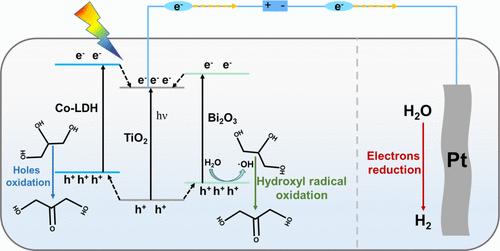Efficient Photoelectrocatalysis of Glycerol to Dihydroxyacetone and Synergistic Hydrogen Generation via Dual Oxidation Pathways Using Co-LDH/Bi2O3/TiO2 Ternary Array
IF 11.3
1区 化学
Q1 CHEMISTRY, PHYSICAL
引用次数: 0
Abstract
Replacing the oxygen evolution reaction (OER) in photoelectrocatalytic (PEC) water splitting with glycerol oxidation reaction (GOR) not only enhances hydrogen production but also generates high-value glycerol byproducts. In this study, we developed a ternary photoanode, Co-LDH/Bi2O3/TiO2, by loading particulate Bi2O3 and linear Co-LDH onto a TiO2 nanorod for glycerol conversion and hydrogen production. The characterization results confirm the formation of coupled interfaces between Co-LDH and Bi2O3 and TiO2, which improves the visible light utilization and promotes the formation of type II heterojunctions, resulting in a significant suppression of electron–hole recombination and an improvement in the PEC performance. Fourier transform infrared (FT-IR) spectroscopy revealed that the Co-LDH/Bi2O3/TiO2 photoanode exhibited stronger adsorption of glycerol intermediate hydroxyl group and more effective desorption of DHA compared to TiO2 and binary photoanodes (Co-LDH/TiO2 and Bi2O3/TiO2), resulting in high-selectivity glycerol conversion to DHA. Mechanistic studies and density function theory calculations have shown that the binary photoanode Co-LDH/TiO2 oxidizes glycerol mainly through hole oxidation, and the binary photoanode Bi2O3/TiO2 oxidizes glycerol mainly through hydroxyl radical (•OH) oxidation. Therefore, the ternary photoanode constructed (Co-LDH/Bi2O3/TiO2) with a dual heterojunction converts glycerol through the dual pathways of hole oxidation and •OH oxidation. This work demonstrates a promising strategy for developing high-performance photoanodes in PEC systems for glycerol oxidation and hydrogen production, leveraging the synergistic effects of multisemiconductor heterojunctions and multiple oxidation pathways, offering significant potential for practical applications.

Co-LDH/Bi2O3/TiO2三元阵列对甘油制二羟基丙酮的高效光电催化及双氧化协同制氢研究
用甘油氧化反应(GOR)代替光电催化(PEC)水分解中的析氧反应(OER),不仅提高了产氢率,而且产生了高价值的甘油副产物。在这项研究中,我们开发了一种三元光阳极,Co-LDH/Bi2O3/TiO2,通过将颗粒Bi2O3和线性Co-LDH加载到TiO2纳米棒上,用于甘油转化和制氢。表征结果证实了Co-LDH与Bi2O3和TiO2之间形成了耦合界面,提高了可见光利用率,促进了II型异质结的形成,从而显著抑制了电子-空穴复合,提高了PEC性能。傅里叶变换红外光谱(FT-IR)表明,与TiO2和二元光阳极(Co-LDH/TiO2和Bi2O3/TiO2)相比,Co-LDH/Bi2O3/TiO2光阳极对甘油中间羟基的吸附更强,对DHA的解吸更有效,甘油转化为DHA的选择性更高。机理研究和密度泛函数理论计算表明,二元光阳极Co-LDH/TiO2主要通过空穴氧化氧化甘油,二元光阳极Bi2O3/TiO2主要通过羟基自由基(•OH)氧化甘油。因此,构建具有双异质结的三元光阳极(Co-LDH/Bi2O3/TiO2)通过空穴氧化和•OH氧化的双重途径转化甘油。这项工作展示了在PEC系统中开发用于甘油氧化和制氢的高性能光阳极的有希望的策略,利用多半导体异质结和多种氧化途径的协同效应,为实际应用提供了巨大的潜力。
本文章由计算机程序翻译,如有差异,请以英文原文为准。
求助全文
约1分钟内获得全文
求助全文
来源期刊

ACS Catalysis
CHEMISTRY, PHYSICAL-
CiteScore
20.80
自引率
6.20%
发文量
1253
审稿时长
1.5 months
期刊介绍:
ACS Catalysis is an esteemed journal that publishes original research in the fields of heterogeneous catalysis, molecular catalysis, and biocatalysis. It offers broad coverage across diverse areas such as life sciences, organometallics and synthesis, photochemistry and electrochemistry, drug discovery and synthesis, materials science, environmental protection, polymer discovery and synthesis, and energy and fuels.
The scope of the journal is to showcase innovative work in various aspects of catalysis. This includes new reactions and novel synthetic approaches utilizing known catalysts, the discovery or modification of new catalysts, elucidation of catalytic mechanisms through cutting-edge investigations, practical enhancements of existing processes, as well as conceptual advances in the field. Contributions to ACS Catalysis can encompass both experimental and theoretical research focused on catalytic molecules, macromolecules, and materials that exhibit catalytic turnover.
 求助内容:
求助内容: 应助结果提醒方式:
应助结果提醒方式:


